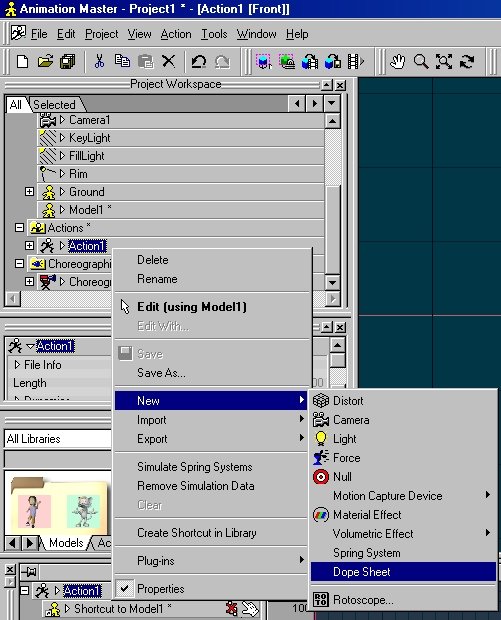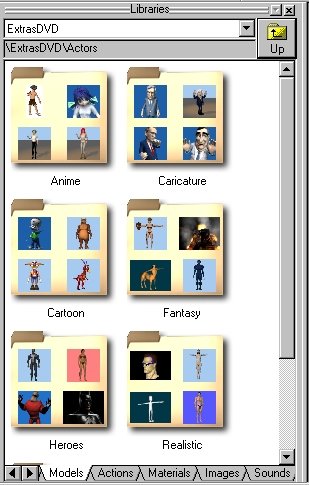-
Posts
21,630 -
Joined
-
Last visited
-
Days Won
114
Content Type
Profiles
Forums
Events
Everything posted by Rodney
-
I use to prefer the method Ken describes (Right Click and add the Light in the Model) and have used constraints to bind lights to Models at times too. I've found another method that seems to be a lot more versatile especially where you aren't sure what changes you may make to lights later on in a project. It grants you a lot of flexibility in editing and adjusting the lights over time and through 3D space. Create an Action (selecting the Model you want to use / it can even be an empty Model) and drag and drop your Lights into the Action. Then when you need the Lights added to the Model you can simply add the Action to the Model in a Choreography. Another benefit is that you should be able to create and organize Libraries of the Lights for reuse later. Yet another benefit if a little thought is put into it... you can apply the Action to other unrelated Models easily without breaking Constraints. Cons of using Lights in Actions? I'm sure there are some but I can't think of any at the moment. Perhaps when using Pose Sliders?
-
Congrats on your purchase and welcome to the A:M Forum! Its great to have you here.
-
Drag and Drop functions in A:M are context sensitive so the answer here isn't an absolute in every case but... in general: Image files can be Drag/Dropped onto selected Groups Sound files can be placed into Actions and Choreographies Model files can be moved into Actions and Choreopgrapies Actions can be dropped onto any model in a Choreopgraphy Choreographies can be added to any project Post Effects can be dropped onto any Camera/Composite All of these will open in their default location if Double Clicked. There is a little more to it but thats what I recall from memory. This is an interesting question and I should know the answer to it. I believe the Folder is a fuction of the text in the Library file itself. To test this you can create a new Folder within a Library and then exit A:M. Then in a Text Editor delete (or better yet... rename) the Folder entry in the .LBR file. When you next open the Library in A:M it will have changed. So... Folder Libraries are created within the Library folder itself. (I'll try to check this again next time I'm in A:M) I believe you've got it. I think you've figured this one out. You are quite correct about the CD data though and those using Libraries should learn this early. You cannot change the data on the CDs easily (exception would be a rewritable CD of course) and therefore you cannot add to those libraries. Futhermore when you attempt to save changes to a model/project referenced on the CD you will get an error. The files need to be copied to harddrive first. Yes. You've got it! What Glenn said.
-
Aaron, You have already have found your answer but... just in case. The question marks are generally an indication that the files are not where they are suppose to be. The Libarary is pointing to them but they aren't where they are expected to be. If you have just installed A:M is it possible that you didn't download the files? (Its a separate download)
-
A:M's pointer(s) to the folder(s) where the .LBR files are located determines what is listed in the dropdown list. To test this try duplicating a Library file. Rename it something distinctive so you will recognize it in your list. You can also create an empty text file and A:M will recognize it in the folder as an empty Library as long as it has the .LBR extension. If you open a Libary file in a text editor you'll see the answer to this question on display. Library files are text files with the type of resource and the location of the resource listed. The user doesn't see the shortcut though... they see the graphic representation of an assigned Preview Image. Of note, the Preview Image for the resource is part of the resource itself. Break the shortcut/link and the image is lost too. If there is no Preview Image asssigned by the user and the resource is where the shortcut points to A:M assigns a default image to it based on the type of file (model, project, action etc.). You don't add new paths to Models in Options | Folders. The models are added to the Library you place them in via drag and drop, creating the shortcut by Right Clicking and adding the shortcut in the Libary itself, typing in the path of the resource manually in a text editor or via an automated method (Libary Manager for instance). The path to the Libary isn't really related to this as the resources still reside in the place they always have. In this sense you could have multiple Libaries all pointing at similar locations but containing very different data. This does then beg the question... why have a whole lot of Libraries? If you don't need more than 1 or two it might be recommended to keep them to a minimum. Rather than create new Libraries you could instead create Folders within a single Library that can satisfy your needs. Where muliple Libraries may have their best advantage is when sharing files with other people. As long as you have the same Libary and the resources are all in place you will see the same thing as them. When you select 'All Libraries' from the dropdown list you are sure to get duplicate models if you have Libraries that point to the same resources. This can get confusing and you can accidentally wreck a good Libary if you start deleting shortcuts at random. This is another reason to keep your Libararies specialized and to a minimum. Of course selecting the individual Libary will prevent the duplication as only the resources shown in that Libary will be in view. My response here is a bit random. I apologize for that. If you open a .LBR file in a text editor it will be a lot more clear what is going on with Library files. In summary: A:M points to the Libary. The Library points to compatible files. (Actions with Actions, Post Effects with Post Effects, etc.) With Libraries you can then organize, reorganize and access those files with ease (and without moving them from their actual location) via drag and drop or double click.
-
I'm able to get into Community but not on all computers. Everything appears to be working and I had a chat a week or so ago but... generally no one replies to my chats. (must be my breath?) Steve Sappington recently updated the links on several Community tabs and they all work. I do have one computer that refuses to connect. That computer doesn't allow me in to Community at all however so its some setting there. Make sure your Internet Browser's cache is cleaned out. The following is a little too vague. Perhaps you can provide more specifics? The Community window is primary a collection of Links (Support links, A:M Films and TWO wiki at the moment). Other than links and browsing associated with that the Chat window is the only thing I can think of that wouldn't work. Outside of the Community window not working at all of course. As you say you are able to log in at least that works. In a chat window it is a good practice to get into to Right Click and select 'Clear' from time to time. This clears the chat cache and allows new text to come in. If you don't do this clearing process from time to time people may chat but you won't see the text of their words.
-
I've only had a few moments to explore but I'm loving the improvements already. The changes in the face rig alone are tops in my book. Now to find more time to explore. Nice. Great job guys!
-
Something I've had a lot of fun with is changing the Ground model itself or pointing the shortcut with the Ground Model (in the Choreography) to another model. For instance, using the ground model as a guide go in and change things to suit your taste... then save the model out under a new name. In the choreography you can then change the shortcut to point to this new model. Modifying the current ground will work too of course but it works best to rename it. Creating a new Choreography will automatically create the flat Ground plane model so its never too far away. Heck... build a whole collection of various ground planes with different terrains and grass. Add them to your Library so you can easily drag and drop them into a Choreography when you need them. Save those tests!
-

Character Model: for Villikon Chronicles: Mysterre
Rodney replied to GraphicAnime's topic in Work In Progress / Sweatbox
Your usage will determine the method. You can model the skull cap type hair or use particle based hair in A:M. There are benefits and constraints to both methods. If you want to render your images quickly and have full control over your hair you'll probably want to use geometry/modeled hair. The downside of this method is generally it doesn't produce the results most artists seek. If you want the most realistic hair you can get you'll probably want to use particle based hair. The learning curve is steep however as there are a lot of options to choose from and the goal must generally be reached through testing. Using a little bit of both methods will probably produce the best results. A compromise might be to create the look you want with particles, render that to a 2D image with Alpha Channels and map the images made from that onto geometry. -
Save often and incrementally. What is meant by this? When you save your files you generally should save them with numbers appended to the end of the filename; ProjectName001.prj. Then the next time you save the file don't just save it but 'Save As' under a new name/number; ProjectName002.prj. Then you can return to earlier versions of the file should you need to recover a file. You'll also want to consider whether to embed all the resources (models, materials etc) into the Project file or keep them separate. But save first... then you can explore your other options. There are other aspects to consideras well, such as where you keep all of those files and what to do with the images that aren't embedded with the projects. Save often and incrementally... (and consider burning the folders/files to a CD as a backup) Edit: What Matt said directly above!
-
I'm not sure what exactly the process does behind the scenes but it works! The move basically selects the complementary CPs and then reselects the original CPs, most likely reordering them in the process. This seems to be enough to get A:M to recognize that the selection is a legal 5 point patch. Bottom line: It works.
-
Look into 'Aim At' Constraints. You can have your objects point at other objects easily that way. Alternatively you could assign a part of the laser to a bone and 'Translate To' the other object. Adjusting the Ease within the costraint will allow you some flexibility in those instances where you don't want the laser pointing directly at the object (for instance... someone fires the laser and it misses the first time...) Edit: Robert beat me to the reply and I think his method will work well for you. You might add a Pose to the laser that extends the end outward. That way you can adjust the length of the laser on the fly.
-
Thanks for posting this Ken. Its great to get the view into how you work. Nancy said it all better than me so... reread her post in my voice. As of this moment at least 52 other people have downloaded and viewed your video so I'd say others have enjoyed it too. Interesting character too.
-
There will be incompatibility between files saved in/after v13 and v11.1. With v13 the Projects, models etc. changed to a XML compatible text based format.
-
You'll want to be either in an Action or Action window to invoke the Dopesheet used for automating lipsync. Look for it within the 'New' menu.
-
The camera view is the important view in most instances. The camera can also said to be the view of the audience so its their/your Point of View (POV). If you were creating a realtime 3D game you'd likely have to spend more time getting poses to look as good as possible from every view. What you are striving for of course is clarity. Its been said that if you can't tell what is happening with a stick figure drawing of the pose... you most likely need to make changes so the pose will read better. So... when in doubt... consider drawing little stick figure thumbnails.
-
I'd say you are pretty close there with the second take on 'innocence'. You may want to experiment with turning the character to the side just a little bit. Then the pose might read even better. You could alway try the silhouette thing again.
-
Well... my second guess was going to be a shrug as when someone says... "Ooops... Sorry." This new image certainly suggests that. So... the emotion.... "Timid"?
-
Hmmm... my first impression... He's catching a ball (a little unexpectedly) so he's anticipating right as it hits him in the stomache. Am I close?
-
After reading your description I had something pop into my mind that I thought I'd test. It's probably more than a bit of overkill for what you want but the test... tested out. The idea was to create a Path consisting of three splines. - Constrain a card to each of these splines in three instances (IAW its the same card model) - The model has 1 bone and 1 null built into it - The bone is constrained to the Null in an Action - Drop the action on to each of the instances of the Card - Then use the Nulls to direct each Card's orientation (One additional Null/Bone could be used to control them all) - Animating the Ease of each Card on the Paths allows them to decend in whatever order is preferred See animation for a look into the process. It may be fairly useless to you but I felt a little like JohnL3D experimenting. cards.mov
-
Seeing them just in the T poses and not in context of a scene has me at a disadvantage. The feeling I got was similar to your explanation though... that this guy is larger than life. Much much larger than life... so consider that a success. The word grotesque is used here often to describe such characters but is often misunderstood to mean ugly... Cutthroat is definitely not ugly.. he's got great appeal! Jaws from the bond movies was both ugly and appealing of course. He was great fun to look at and as I understand it has a great many fans. I percieve that Cutthroat is going to have a whole lot of fans too. He's my favorite character thus far... I always love to hate those badguys. I assume McCrary is drawing him at similar scale (I love his strip BTW!). You've got the right idea just wanted a little more info on the scale. I'm happy to see you've got that angle covered. Once we see him in actual poses and in his environment it'll all make perfect sense. As always I look forward to your next update.
-
You've worked this one pretty good. Its definitely reading more of a 'victory' than your first image. You can call that pose a success.
-
Mike, I did a fresh copy of the Extra DVD content over to my v15 directory and connected to it via the standard method. I can't help but think its the capital letters that are messing up your connection. If you typed in the address manually thats got to be it. (I don't recommend doing that)













